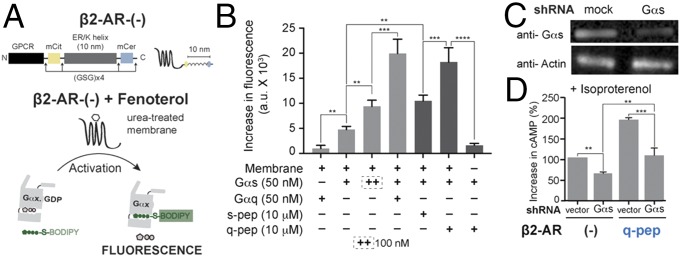Fig. 3.
Synergism between Gαs and a C terminus peptide causes GPCR priming. (A) Schematic representation of Gα subunit activation measured in vitro by increase in fluorescence of BODIPY-FL–GTPγS. Activation is triggered by addition of fenoterol to urea-treated membranes containing the β2-AR control sensor (−), harboring an ER/K linker. (B) Effect of Gα proteins (+, 50 nM; ++, 100 nM) and soluble Gα C terminus peptides (10 μM) on the in vitro activation of Gαs by fenoterol treatment of β2-AR. Gαq causes synergistic activation of Gαs. s-pep and q-pep increase the activation of Gαs, with q-pep showing an augmented increase. (C) Western blot of lysates from HEK293T cells expressing Gαs shRNA compared with vector-transfected cells (mock). At equivalent loading (anti-Actin), shRNA-expressing cells are depleted of Gαs protein (anti-Gαs). (D) Change in cAMP levels due to Gαs depletion in cells expressing either β2-AR control (−) or β2-AR-q-pep sensors. In both sensors, depletion of Gαs reduces cAMP levels. Values are mean ± SEM from n ≥ 5 observations from three independent experiments (B) and n ≥ 10 observations from three independent experiments (D). **P < 0.01, ***P < 0.005, ****P < 0.001 by unpaired t test.

